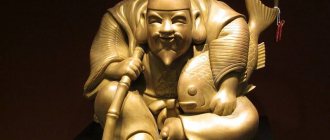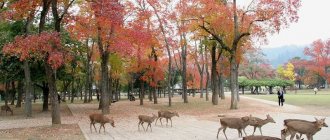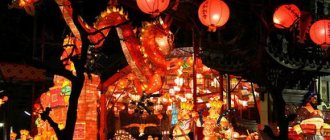For many centuries, the Land of the Rising Sun attracted Christian missionaries. And it might seem that Japan would easily accept the new faith instead of the polytheism alien to the Western world. But this did not happen. The Japanese remain devoted to the religion of their ancestors - Shinto.
This amazing tradition seems incredibly incomprehensible to outsiders. Colorful, angular temples made of wood soar upward. They look nice, but they don't tell you anything about what's going on inside.
What does a typical temple like in Japan look like? And is there a place for Christianity in this mysterious world? Let's discuss this.
Japan's main religion is Shinto: belief in kami, harmony and responsibility for one's actions.
There are representatives of different religions in Japan, but the predominant one is Shintoism. It is quite difficult to distinguish pure Shintoism from those mixed with other teachings.
This religion has been influenced by different schools of Buddhism over the millennia. Because of this, it contains a lot of borrowings. Today they are already inseparable from the main tradition.
Shintoism is not considered paganism.
Shintoism is similar to typical paganism: polytheism (polytheism) reigns in it. But it is not customary to call this culture pagan. This definition is appropriate in relation to the extinct religions of some ancient peoples. Shintoism is distinguished by the following characteristics:
- he is the main religion of one of the most influential powers;
- he withstood the pressure of Christian and Buddhist preachers;
- he welcomes scientific progress and is generally quite democratic towards innovation, which makes it difficult to associate Shintoism with something backward and pagan.
Therefore, no one calls Shintoism paganism, although it has formal signs of such.
It is almost impossible to convey the entire creed, but the main points are as follows:
Everything in the world has a kami - a spiritual essence.
Westerners immediately want to put a label on it and clarify: “What does every blade of grass have? Is Kami a soul or a god? No, a kami is a kami. We can call kami spirits, but this will already distort the original source.
So, even a stone, a place, a phenomenon has a kami. There is probably nothing that doesn't have a kami. Without a kami, a thing simply does not exist. Families, dynasties, etc. have kami.
Accordingly, if you want well-being, you need to turn to the “family” kami, you want good weather, you should pray to the kami of the Sun, etc.
You can become a kami. At the very least, the patrons of childbirth are the spirits of deceased ancestors.
The main thing is harmony. There is no devil or supreme good God. There are no evil titans and positive Olympians. There is no such thing as absolute evil. Actions are dictated by circumstances. In a global sense, there are only things that are useful and harmful to the world.
Let's say if a person pollutes the environment, this is a global problem and inappropriate behavior. But if he has enmity with his neighbor and intrigues against each other, these are issues of interpersonal relationships, where everyone is right in their own way.
By protecting the interests of your family, you infringe on other people. These are already circumstances, you can’t escape them, you won’t be good for everyone. What does it mean to be good? Have the following qualities:
- sincerity;
- good nature;
- friendliness;
- compassion.
Etc. But a bad person is an egoist, a villain, a rude person, one who does evil not for reasons, but for his own pleasure. In general, the one who destroys the overall harmony.
Therefore, in Shintoism there is no place for the general assessments inherent in Christianity. All cases are individual. Killed - why? Robbed - why? Suddenly, there was a respectful motive.
Souls themselves determine their place in the world.
In Shinto there is no idea of a savior or punishment for sins. A person's actions themselves determine his future. What guided you yesterday will influence your future tomorrow. You were born there and who you deserve due to the past experience of your soul.
A sincere, kind person has nothing to fear.
The most amazing temples in Japan
The culture of Japan as a whole is unique, and its architecture, as its most striking manifestation, is unlike the architecture of any other country in the world. At first glance, the temples of the Land of the Rising Sun are simple, spacious and bright. Despite the asymmetry, multi-level, intricate roofs, they do not look pretentious and fit very harmoniously into the surrounding landscape and natural environment. Today we will introduce you to the best creations of Japanese architects, which are little talked about in Europe, but which definitely deserve attention.
japanvisitor.com
1.Todai-Ji
Todai-ji is the world's largest temple built of wood. It is included in the UNESCO World Heritage List and is one of the key monuments of Buddhist culture. The history of the great structure began in 743, when epidemics and droughts raged in the territory of the modern city of Nara. To protect his people from harm, the then Emperor Shomu ordered the construction of a giant Buddha statue. To build the 15-meter statue, it was necessary to use almost all the bronze available in the country and the labor of 2 million people. The work on the statue was completed in 745, and in 1709 a colossal wooden pagoda was built around it. In the area surrounding the temple, a deer park was established, several high gates were built, and unique finely crafted wooden statues were installed. Todai-ji attracts hundreds of tourists every year, who come here mainly to visit the incense burner. Its smoke, according to legend, cleanses both the mind and body of a person.
khanacademy.org
2.Hofuku-Ji
This Buddhist temple is located near Todai-ji, in Nara. Although it was originally built in the city of Kyoto, it was only later, in 710, that it, along with the capital of the state, was moved to Nara. Hofuku-Ji stands out among other religious buildings with a pagoda that is 50.8 meters high and has five floors. Over time, it was reconstructed and changed. Another, no less beautiful pagoda, contains three floors. It is considered the most ancient. In 1180 it survived a global fire, but was soon rebuilt. On the territory of the temple there are iconic sculptures and ritual altars, which, like the entire complex, are protected by UNESCO.
chinabuddhismencyclopedia.com
3.Enryaku-Ji
The temple was built on a mountain near the former capital of the Empire, Kyoto. It was founded by Buddhist monks in the 8th-9th centuries. This temple had a huge influence on the formation of not only the Buddhist religion, but also Japanese culture and history. It was here that the Tendai school was located, starting in 807. Young people thirsting for enlightenment went there for 12 years to learn their wisdom from Buddhist monks and learn the roots and history of the religion. During its heyday, Enryaku-Ji grew to unimaginable proportions. At its best, it included 3 thousand buildings and even had its own army, which defended the temple in case of danger, and participated in the bloody wars waged by the Empire.
Shinto shrines are dedicated to kami, the Japanese ask them for help
Japanese temples are represented mainly by Shinto shrines. They are called jinja. There are about 100,000 of them.
100 000
approximately the same number of Shinto shrines in Japan
Temples are built in honor of a kami. The sanctuaries have several buildings. They are carried out in such a way that the building does not discord with the surrounding space, but harmoniously fits into nature.
One of the main elements is the red gate, torii.
Torii - gateway to a Shinto shrine
There are no icons or statues of kami in the temples. But there may be images of animals to evoke associations with the desired kami.
There is a pool or other body of water in front of the temple: to perform a cleansing ritual before entering. You need to wash your hand using a ladle, draw water into it and rinse your mouth, and at the end draw water for the next visitor.
A mandatory sign of a sacred place is a shimenawa rope. It is made from straw. She points out that there are kami living here.
The shimenawa rope indicates that the temple is inhabited by kami
Other attributes can be seen:
- sword, shield, halberd. This is a way to protect the kami and at the same time a sign of their power;
- flags. These are offerings for the kami. If there are a lot of flags, it means that believers often come here;
- bell. There are often bells or bells hanging outside the temple. The Japanese believe that their sound is unbearable for the evil Komi. You can call.
There are many popular rituals in Japanese temples. Here are two:
- Place the Komi coin and clap your hands twice. Then mentally pray in random words;
- Leave a note with your wish. Then they will burn it, and the Komi will find out what the person is asking of them.
On the territory of the temple you can get a prediction. Take the good things with you, and tie the bad things to tree branches so that they don’t come true.
There is an inner sanctum inside the temple. If a building was erected in honor of several kami, then there are several shrines.
The most impressive temples in Japan
Japanese architecture developed under the influence of two factors: religion and the influence of China. This is especially true for church architecture, because it was from the Celestial Empire that Buddhism penetrated into the Land of the Rising Sun.
At the same time, we should not forget that the country has a national religion - Shintoism, which also contributed to the construction of the most impressive temples in Japan.
When coming to Japan, you can’t help but visit the amazingly beautiful temples.
Despite their diversity, there are some that are especially unique:
- Yakuri-Ji. Located on Mount Goken, near the city of Takamatsu on the island of Shikoku. It is worth noting that the island itself is a place of pilgrimage for Buddhists from all over the world, since there are 88 temples of the Japanese monk Kukai, who lived in the 9th century. The main cathedral, Yakuri-Ji, was also founded by him, but acquired its modern appearance only in the 17th century. You can get to the premises using a funicular. In addition to the beauty of the structure, the mountain offers a fantastic view of the city.
- Rean-Ji . Another center of Buddhism. Located in the city of Kyoto. It was built more than 500 years ago, but was repeatedly rebuilt from scratch due to fires. In 1945, the Americans could have dropped an atomic bomb on the city, but at the last moment they changed their destination: they replaced Kyoto with Nagasaki. Today, Rean-Ji is included in the UNESCO list of architectural heritage. Part of the cathedral is the famous rock garden in Japan.
Many tourists come here specifically to think about eternal philosophical questions.
- Meiji . This is a Shinto shrine. It does not have such a rich past as many Buddhist temples, but the history of Meiji is closely connected with the development of the country. In the 19th century, the emperor was returned to power in the country after two centuries of military rule. Therefore, they began to massively revive and create Shinto shrines, since in this religion the emperor is sacred. It was Meiji who became the first emperor after the military, who began the Europeanization of the country. The Museum of the History of Japan and Emperor Meiji is also located here.
- Itsukushima . The most popular temple among tourists. The gate is located close to the sea, so it is sometimes flooded, which gives the structure additional mystery. The gate is painted red and is a symbol of all of Japan. The temple itself stands on wooden stilts, so you can move between its parts using a boat.
- Orthodox Cathedral of Nicholas-Do in the capital of Japan, Tokyo. In 1872, the mission of Archimandrite Nicholas arrived here. Despite the further deterioration of relations between Japan and the Russian Empire, the authorities of the former did not close the temple.
When visiting Japan, tourists should definitely visit these places to immerse themselves in the atmosphere and culture of the country.
Famous Japanese Shinto Shrines: 3 Examples
Meiji Jingu is the largest Shinto shrine in Japan. Created relatively recently - in 1920. Has a huge surrounding area - 708,200 m²
Meiji Jingu is the largest Shinto shrine in Japan
Itsukushima is one of the most popular temples in Japan. Located on the island of the same name. A distinctive feature of the temple is the gate, which is flooded during high tides.
Flooded Gate of Itsukushima Shrine
Nikko Tosho-gu - founded in 1617. Eight of its buildings are recognized as national treasures of Japan.
Nikko Tosho-gu
Shinto shrines in Japan
Shintoism was formed in Japan long before the birth of writing. This religion is based on the belief that everything that has a soul can be gods. Shinto temples in Japan were built so that the Japanese would come to the holy building to thank the gods for a good harvest or to ask nature for favors.
Meiji Shrine
Meiji Shrine is located in Tokyo. This is a Shinto shrine, the construction of which was carried out in honor of Emperor Meiji and his wife. The plan according to which construction should begin was drawn up during the couple’s lifetime. But its implementation followed only after their death.
The main building is surrounded by trees. It is made in the traditional Japanese style, which is called Nagarezukuri. The garden that surrounds the temple contains all the varieties of trees and shrubs that grow in Japan. The northern part of the temple complex is occupied by a building housing a museum. This building is made in the Azekurazukuri style.
The territory of the complex also includes a wedding hall where Shinto weddings are held. The events held here involve a number of activities of a religious nature.
Itsukushima Shrine
Itsukushima is a Shinto shrine in Japan located on the sacred island of Itsukushima. It is located in the Inland Sea of Japan. It is not so easy for an ordinary person to get to the island, it is considered so sacred.
Itsukushima can be considered one of the most popular temples in Japan. It stands out noticeably against the background of other architectural structures. The main difference is the gate, which is located in close proximity to the sea. Periodically, during high tides, the gates are flooded. It was in this flooded state that they became a symbol not only of the island, but of the entire state. In Shintoism, temple gates carry not only the function of decoration, but also a semantic load. Itsukushima Gate is painted bright red and made of wood.
The temple complex includes many buildings, each of which is painted white and has a red roof. The main part of the buildings is intended for special rituals, which are not available to every tourist who decides to learn a little more about Shintoism.
The sanctuary is not located on the ground, but on stilts that are located above the water level. Another distinctive feature of Itsukushima can be considered the presence of a large stage on which you can watch performances in the Noh genre.
Toshogu Shrine
The Toshogu Shinto temple complex was built in honor of the commander Tokugawa Ieyasu. At the end of the 20th century, the sanctuary was included in the list of sites under UNESCO protection. Toshogu Shrine is where the burial place of General Ieyasu himself is located.
A distinctive feature of the temple is that its eight main buildings are national treasures of Japan. These include: Yomei-mon, Honden, Hayden, Ishi-no-ma and others. The remains of Tokugawa are located in an urn made of bronze. It is located in the Okusha-hoto building. Previously, this room was made of wood, and then reconstructed into a stone structure. A little later, the need arose to protect the pagoda from moisture. For this purpose, she transformed it into a bronze building.
The Japanese also practice Buddhism, a belief in liberation from suffering through Enlightenment.
Another influential religion in Japan is Buddhism. It is difficult to talk about it in general, because it is not a single movement, but a number of schools with often contradictory views. For example, in Buddhism, as you know, there is no god. But there are directions in which divine beings are revered.
And yet, we can identify something common to all Buddhism. We call it religion, although this is due to misunderstanding. In reality this is a teaching, a path. Buddhism is the science of how to achieve enlightenment. There is almost no place for rituals and worship, only self-development practices and philosophy.
Buddhism is not a religion, but a teaching.
Buddhists believe that the material world is a trap. It will never bring satisfaction to a person. The true spiritual nature lies on the other side, in Nirvana. But it’s simply impossible to get there.
It is necessary to achieve a special state - Enlightenment, to realize one’s spiritual nature.
There are many tools for this - from moral and ethical rules to meditation. At the same time, a person needs to maintain a golden mean between extreme asceticism and life in abundance.
Honmon-ji
This is another interesting temple, also called Ikegami Hondmonji. It owes its appearance to the prominent preacher Nichiren, who even founded his own school of Buddhism.
Image of Nichiren
His life was full of bright events, devoted students and a constant search for truth. But one day Nichiren fell ill and decided to go to hot springs for treatment. Along the way, he stopped with one of his followers.
Here the disease overcame him. Realizing that he was dying, on the advice of his disciple Nichiren decided to found a monastery. Three weeks later, the teacher died, and a temple appeared on this site, which became a monument to his life and teaching.
The construction of the temple was assisted by Ikegami, who provided his land and supervised the construction of the walls. Later, during the Second World War, the temple suffered significant damage due to bombing, but still managed to survive.
Today, everything is the same here, several centuries ago, there are beautiful gates and a red pagoda, which consists of five levels and can withstand even magnitude 7 earthquakes. It was in this pagoda that Nichiren's body was cremated after his death.
Honmon Temple, Tokyo, Japan
Nearby there is a mausoleum, which was erected on the seven hundredth anniversary of the death of the teacher. It is notable for the fact that it was built entirely from cypress wood. And every year, on the memorable date of the death of the founder of the temple, thousands of lanterns light up here.
Many Buddhist temples in Japan are very ancient and have become world heritage sites.
Buddhist temples in Japan did not immediately acquire their own style. Buddhism originally migrated to the Land of the Rising Sun from China. Therefore, the architecture at first completely imitated the Chinese.
But over the centuries she became more independent. Today there are many Buddhist temples in Japan. Including very ancient ones.
Daigoji is a Buddhist temple complex. It was founded in 874, although the oldest building, a five-tiered pagoda, dates back only to 951.
Yet Daigoji is a well-preserved example of ancient Japanese architecture. Included in the UNESCO heritage. Notable for its very beautiful rock garden.
Daigoji Temple Complex
Asakusa Kanon (Senso-ji) is one of the oldest in Japan. Founded in 645. But today only a copy stands in its place - the original building was destroyed in World War II.
Buddhist Temple Asakusa Kanon
Buddha statue at Kotoku-in Temple
Kotoku-in is remembered for its eleven-meter tall bronze Buddha statue. The statue was originally made of wood, but in 1248 it was destroyed by a storm.
Modern temples in Japan - seven striking examples
The temple architecture of Japan, like many other aspects of Japanese culture, at one time took a lot from the Chinese, especially since Buddhism, imported from the Middle Kingdom, was actively integrated into the system of traditional animistic beliefs, which we know today as “Shinto”. However, local temples were rarely copies of their Chinese counterparts - due to the humid climate, builders had to use different materials and techniques. In addition, Japanese art and architecture have always gravitated towards a specific simplicity, in contrast to Chinese primary sources.
By creating temples now, architects combine the experience of innovation and experimentation, with respect for the multifaceted historical heritage and traditions of the Land of the Rising Sun. This is achieved through a delicate balance of contrasting elements: new materials and natural textures, light and shadow, as well as open and closed spaces.
We have seven temples that demonstrate a wide range of architectural styles. Religious architecture in Japan continues to evolve, while maintaining an atmosphere that is in tune with the culture and aesthetics of the country of eight million local and alien gods.
Ekoin Nenbutsudo / Yutaka Kawahara Design Studio, Tokyo Minimalist design elements and materials reference the urban context in which the temple is located, while the building is surrounded by vegetation on all sides - a green terrace with bamboo plantings adds a natural motif.
White Temple / Takashi Yamaguchi & Associates, Kyoto The snow-white rectangular volume depicts a kind of look into the future, contrasting with the more traditional architecture located nearby.
Koenji Temple / Shri Kakinuma, Fukuoka The main material here is wood. It is used for both external and internal decoration. A variety of shades and textures create unique mood scenarios in different locations inside and outside the building.
Shinkoji Temple / Mamiya Shinichi Design Studio , Aichi Prefecture The geometric concrete body creates a series of closed and open spaces. Along the perimeter of the temple there are also large windows that provide the interior with natural light.
Harajuku Temple / Ciel Rouge Creation, Tokyo The six smoothly curved concrete arches that form the vault of the building symbolize the sky.
Glass Temple / Takashi Yamaguchi & Associates, Kyoto A futuristic temple with laconic outlines is located below ground level, light penetrates inside through a glass roof. The exterior of the Glass Temple is surrounded by traditional architecture.
Myoen-ji Columbarium / Furumori Koichi Architectural Design Studio, Fukuoka Light enters through the multi-layer lattice wooden roof, illuminating the room where randomly placed wooden columns create a special atmosphere.
Until 1873, Christianity was banned in Japan; today there are 2.5 million Christians
Christianity is poorly represented in Japan - 2.5 million people. These are predominantly Protestants. In the 16th century, Christian missionaries preached in Japan without much success, as they disdained the Japanese faith and traditions.
Accusing their ancestors of paganism was a fatal mistake for the missionaries, as the Japanese did not want to accept the idea that their great-grandfathers were languishing in hell.
And yet, a small number of Japanese were converted to Christianity. The authorities were indifferent to the sermons for some time, but by 1639, when the policy of isolation from the West began, Christians were either executed or forcibly converted to Buddhism.
It was only in 1873 that the Japanese authorities reluctantly lifted the ban on preaching under external pressure. Before this, many “underground” Christians were executed in the Land of the Rising Sun.
0,03 %
of the total population of Japan are Orthodox
Orthodox Christians make up 0.03% of Japan's total population and are part of the Japanese Orthodox Church. Japanese Orthodox Odera Hiroshi talks about the difficulties of the existence of the Orthodox Church in Japan:
“In traditional Japanese religions, everything is much simpler: you go to the temple, throw a coin into the altar, bow, and the job is done.
Secondly, it is very difficult to understand the language of worship. Again, you need to make an effort, think about it, or deliberately sit and understand the text.
In addition, many people do not understand why one cannot just get married in such a beautiful temple if the bride is Orthodox and the groom, for example, is a Buddhist or Shintoist.
What's bad about it? Why does he have to become Orthodox?
In Catholic churches and Protestants this is not a problem - marry for health. Think for yourself: wouldn’t it be easier for a Japanese, for whom the religious difference is not obvious, to take a simpler path?”
And yet, in 2006, they were even able to found the Monastery of St. Nicholas of Japan in Japan.
Small building of the monastery of St. Nicholas of Japan
Todai-ji
Another site under the protection of UNESCO is Todai-ji, or Todaiji - both spellings are possible. This is the largest wooden temple, it belongs to the Kegon movement, is located in the city of Nara, and it appeared here for a reason.
When Japan suffered one after another in the form of earthquakes and hurricanes, the ruler of Shomu in the mid-8th century called on local residents to build a statue of Buddha who would protect them from harm. More than two million people were involved in the construction, and the group was headed by Kuninaka-no-Muraji Kimimaro.
In 745, the Todaiji Temple was erected, and six years later - a statue of Buddha Vairochana, created from bronze.
Bronze Buddha statue at Todaiji Temple, Japan
The dimensions of the Buddha, which was assembled in parts, are impressive:
- height (sitting) – 15 m;
- head – 5 m;
- eyelids – 0.5 m;
- nose – 1 m;
- ears – 2.5 m;
- weight – 500 tons.
I wonder what
Almost all the bronze mined in Japan at that time was used to make the bronze Buddha statue.
Over its centuries-old history, the temple has suffered disasters in the form of fires, earthquakes and has repeatedly changed its appearance. In the version in which the monastery appears to visitors now, it was decorated at the beginning of the 18th century.
Now it is a fairly large temple complex. Its main gate is clearly inferior in grandeur to the 25-meter southern entrance, richly strewn with skillful carvings and wooden figurines.
Todaiji Temple, Japan
There is also a smoking room where you can drown in clouds of smoke. They are said to purify the physical body, mind, thoughts and soul.
Behind the walls of one of their buildings are stored real treasures that are fraught with historical value: ancient relics, sacred manuscripts. Incredible treasures were found here only a century ago, walled into the floor under a Buddha statue - these are the Yohoken and Inhoken swords. For more than a thousand years they were considered lost, until in 1907 researchers found sacred engraved swords covered with gold and silver precious coating.
There are many buildings in the Todaiji complex, such as the February - Nigatsudo - and March - Sangatsudo pavilion. But the main asset of the temple area, which can bring all visitors to the heart, is the deer park. The animals quietly roam around the territory - they are considered sacred, so many people want to pet them and feed them.
I wonder what
There are small holes at the bottom where the columns of the main building are located. It is believed that whoever manages to crawl into this passage will be endowed with enlightenment. Children pass there with ease, but an adult stuck in this passage is a common sight.
Orthodox churches in Japan
Resurrection Cathedral (Nikorai-do) is a cultural monument of the Japanese state. Executed in the Russian-Byzantine style. The last restoration took place in 1988. Gold and platinum were used in the design of the iconostasis.
It has the status of a cathedral of the Japanese Autonomous Orthodox Church and its own printed publication.
Resurrection Cathedral (Nikorai-do), an Orthodox church in Japan
Official website of the Church of the Resurrection of Christ (Hakodate)
Church of the Resurrection of Christ (Hakodate) was founded in 1859. This is one of the main symbols of Orthodoxy in Japan. There is a Sunday school, there is an official website of the church.
Church of the Resurrection (Hakodate)
By leaving a comment, you accept the user agreement
How to visit the temple
Be calm and respectful. Show your respect by tossing a coin in the offering box. Then recite (pretend to) a short prayer in front of the sacred object.
In some temples, visitors burn incense (Osenko) in large incense burners. Buy a pack, light them, let them burn for a few seconds, and then put out the flame by waving your hand rather than blowing it out. Finally, place the incense in the incense burner and hold some of the smoke near you, as the smoke is believed to have healing powers. For example, if you have an injured shoulder, apply some smoke to your shoulder.
You may be required to remove your shoes when entering temple buildings. Leave your shoes on the shelves at the entrance; if you are concerned about their safety, take them with you in a plastic bag provided in some temples. Wear nice, intact socks. Remove your headdress.
Photography is usually permitted on temple grounds, but is often prohibited inside buildings. Follow the explanatory signs.
Views: 1,691
Share link:
- Tweet
- Share posts on Tumblr
- Telegram
- More
- by email
- Seal
Liked this:
Like
Orthodox Life
Nikolai-do (lit. “Nicholas Temple”) is the Orthodox Cathedral of the Resurrection of Christ, one of the most famous attractions in Tokyo.
Not a single local guide will fail to draw the attention of his companions to the greenish dome, which differs from the usual examples of traditional Japanese architecture, but nevertheless fits perfectly into the urban landscape of the Japanese capital.
Link to St. Nikolai is understandable. After all, both the very idea of building this Orthodox church in Tokyo and the concerns of putting it into practice are connected with St. Nicholas (in the world Ivan Dmitrievich Kasatkin), who headed at the end of the 19th - beginning of the 20th centuries. Russian spiritual mission in Japan.
Father Nikolai looked around, and then, having collected the necessary amount, bought a plot of land on the top of the Suruga-dai hill in the Kanda region. There, during the Middle Ages, there was a fire tower, which also served as a kind of lighthouse for ships entering the port of Edo. It was decided to build an Orthodox cathedral on this hill.
The initial sketch of the future temple was developed by the famous St. Petersburg architect, professor A. Shchurupov (1815–1900). It was his idea to build a building resembling a Greek cross in plan, but with domes in the Byzantine style.
However, it was up to someone else to translate the idea into stone and metal. Construction was entrusted to the English architect Joshua Conder (1852–1920), who erected more than 50 buildings in Tokyo between 1878 and 1907. Thus, he was the author of the construction of the Tokyo Imperial Museum (1881), the Rokumeikan Palace (1883), and the building of the Maritime Ministry (1895). And in 1891, Conder presented Archbishop Nicholas with the keys to the Cathedral of the Resurrection of Christ.
Brick walls surrounded the interior space of the temple of 805 square meters. m. The dome was lined with copper sheets, which over time, having oxidized, lost their original shine and acquired a greenish tint.
Alas, the St. Nicholas Cathedral has not been preserved in its original form. In 1923, the building was seriously damaged by a devastating earthquake. By 1929, the temple was restored by the Japanese builder Shinichiro Okada, who could not resist and made some adjustments to the original appearance of the cathedral. Changes affected the dome, bell tower and part of the interior, but in general the temple retained much of A. Shchurupov’s original ideas.
The Church of the Resurrection of Christ is the cathedral of the autonomous Japanese Orthodox Church, part of the Moscow Patriarchate. The temple has the official status of an important cultural monument of the Japanese state
Now Nikolai-do is somewhat lost among the tall buildings built in recent years in the center of Tokyo. But the place successfully chosen by St. Nicholas allows him to still majestically flaunt over the surrounding area, attracting the views of passers-by and the hearts of believers.
Based on materials from the Japan Today website










